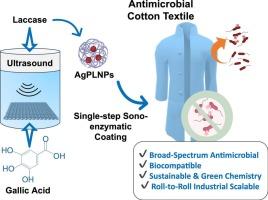用抗菌银酚醛木质素纳米复合材料扩大棉织物的声酶包覆
IF 9.7
1区 化学
Q1 ACOUSTICS
引用次数: 0
摘要
控制医疗机构感染的迫切需求促使了高效抗菌纺织品的发展。在这里,我们提出了一种简单和可扩展的方法,用于工程耐用的抗菌棉织物,使用单步声酶法。涂层过程包括在超声波条件下(20 kHz频率,17.30 W/cm2功率强度,35%振幅,50°C, 30分钟)使用Ti-horn超声波换能器同时漆酶酶催化没食子酸(GA)氧化,产生生物基粘合剂网络,结合GA和抗菌银酚化木质素纳米颗粒(AgPLNPs)的氧化酚壳,并将其沉积在织物上。研究了三种涂布配方:纯棉织物超声处理AgPLNPs (M1)、AgPLNPs和漆酶(M2)、AgPLNPs、GA和漆酶(M3)。AgPLNPs牢固地嵌入在棉织物上,无需织物预活化或后处理。它们具有生物相容性,对革兰氏阳性(金黄色葡萄球菌)和革兰氏阴性(铜绿假单胞菌和大肠杆菌)细菌具有广谱抗菌活性,并且与传统抗生素相比,诱导细菌耐药性的倾向显著降低,MIC仅增加2-4倍,而环丙沙星和氨苄西林的MIC增加128-2048倍。所得的agplnps - ga涂层纺织品(M3)显示出持久的抗菌性能,在医院在75°C下进行60次洗衣循环后保持95%的抗菌效率,符合国际热消毒指南(98.6 - 99.8%,具体取决于细菌菌株)。此外,涂层织物具有生物相容性和疏水性(接触角:116.1±1.5°),增强了其在医疗环境中的作用,在医疗环境中,体液排斥对于保持卫生和防止病原体传播至关重要。该涂层成功地从实验室样品(10 × 10厘米)扩展到工业规模加工尺寸为5 × 0.5米的纺织品,使用连续的卷对卷声化学试验。这种新颖的涂层方法有望为医疗用途创造特别耐用的抗菌和生物相容性织物。本文章由计算机程序翻译,如有差异,请以英文原文为准。

Scaling up the sono-enzymatic coating of cotton textiles with antimicrobial silver-phenolated lignin nanocomposites
The pressing demand for controlling infections in healthcare facilities has prompted the development of highly efficient antimicrobial textiles. Herein, we present a simple and scalable approach for engineering durable antimicrobial cotton textiles using a single-step sono-enzymatic process. The coating process involves simultaneous laccase enzyme-catalysed gallic acid (GA) oxidation under ultrasonic conditions (20 kHz frequency, 17.30 W/cm2 power intensity, 35 % amplitude, 50 °C, 30 min) using a Ti-horn ultrasonic transducer, generating a bio-based adhesive network that engages both GA and the oxidised phenolic shell of antimicrobial silver phenolated lignin nanoparticles (AgPLNPs), and their deposition on the fabrics. Three coating formulations were investigated: cotton fabric ultrasonicated with AgPLNPs alone (M1), with AgPLNPs and laccase (M2), and with AgPLNPs, GA, and laccase (M3). The AgPLNPs are firmly embedded on the cotton fabric, eliminating the need for fabric pre-activation or post-treatment. They are biocompatible, possess broad-spectrum antibacterial activity against Gram-positive (Staphylococcus aureus) and Gram-negative (Pseudomonas aeruginosa and Escherichia coli) bacteria, and have significantly less propensity to induce bacterial resistance than conventional antibiotics, showing only 2–4 fold increases in MIC compared to 128–2048 fold increases for ciprofloxacin and ampicillin. The resulting AgPLNPs-GA-coated textiles (M3) demonstrated durable antibacterial properties, retaining >95 % antibacterial efficacy after 60 hospital laundry cycles at 75 °C, following international thermal disinfection guidelines (98.6–99.8 % depending on bacterial strain). Additionally, the coated fabrics were biocompatible and hydrophobic (contact angle: 116.1 ± 1.5°), enhancing their benefits in medical environments where body fluid repellence is crucial for maintaining hygiene and preventing the spread of pathogens. The coating was successfully scaled up from laboratory samples (10 × 10 cm) to industrial-scale processing of textiles with dimensions 5 × 0.5 m using a continuous roll-to-roll sonochemical pilot. This novel coating approach shows promise for creating exceptionally durable antimicrobial and biocompatible fabrics for medical purposes.
求助全文
通过发布文献求助,成功后即可免费获取论文全文。
去求助
来源期刊

Ultrasonics Sonochemistry
化学-化学综合
CiteScore
15.80
自引率
11.90%
发文量
361
审稿时长
59 days
期刊介绍:
Ultrasonics Sonochemistry stands as a premier international journal dedicated to the publication of high-quality research articles primarily focusing on chemical reactions and reactors induced by ultrasonic waves, known as sonochemistry. Beyond chemical reactions, the journal also welcomes contributions related to cavitation-induced events and processing, including sonoluminescence, and the transformation of materials on chemical, physical, and biological levels.
Since its inception in 1994, Ultrasonics Sonochemistry has consistently maintained a top ranking in the "Acoustics" category, reflecting its esteemed reputation in the field. The journal publishes exceptional papers covering various areas of ultrasonics and sonochemistry. Its contributions are highly regarded by both academia and industry stakeholders, demonstrating its relevance and impact in advancing research and innovation.
 求助内容:
求助内容: 应助结果提醒方式:
应助结果提醒方式:


